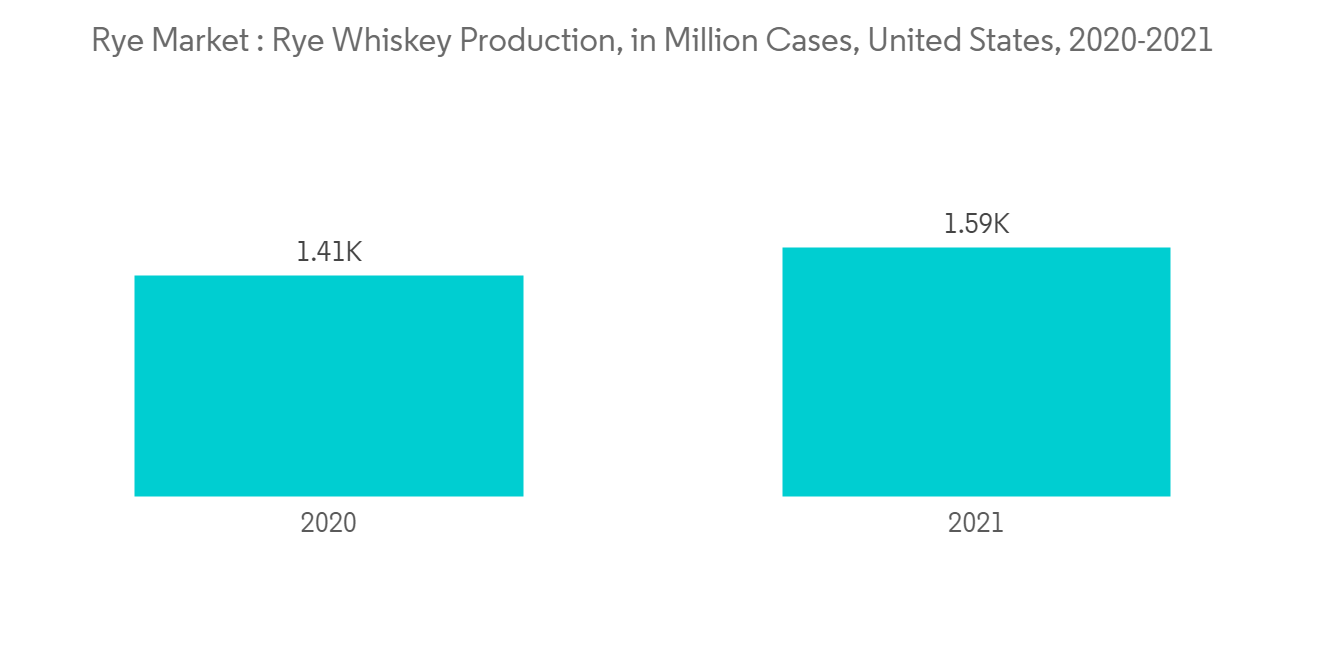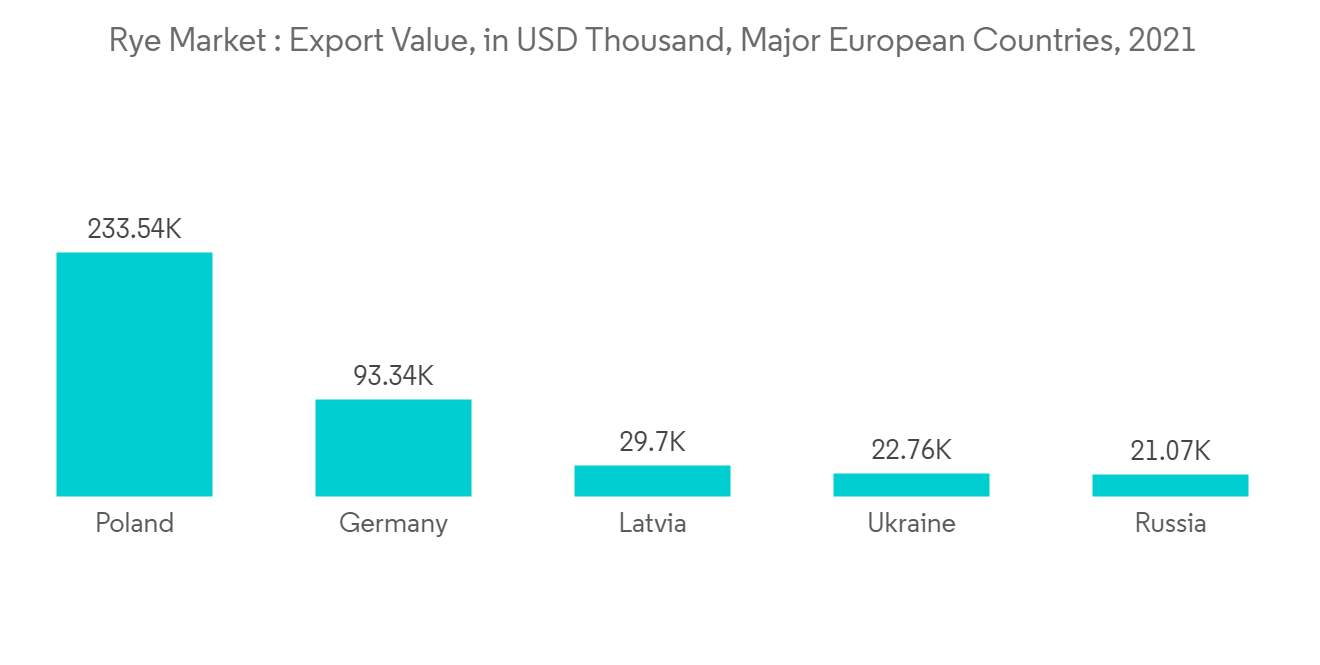 |
市場調査レポート
商品コード
1258770
ライ麦市場- 成長、動向、予測(2023年-2028年)Rye Market - Growth, Trends, and Forecasts (2023 - 2028) |
||||||
● お客様のご希望に応じて、既存データの加工や未掲載情報(例:国別セグメント)の追加などの対応が可能です。 詳細はお問い合わせください。
価格
| ライ麦市場- 成長、動向、予測(2023年-2028年) |
|
出版日: 2023年04月14日
発行: Mordor Intelligence
ページ情報: 英文 80 Pages
納期: 2~3営業日
|
ご注意事項 :
本レポートは最新情報反映のため適宜更新し、内容構成変更を行う場合があります。ご検討の際はお問い合わせください。
- 全表示
- 概要
- 目次
概要
ライ麦市場は予測期間中に2.2%のCAGRで推移すると予測されます。
主なハイライト
- ライ麦は、ビタミンB6、チアミン、ナイアシン、鉄、葉酸、食物繊維、リボフラビンを豊富に含んでいます。また、少量の亜鉛、パントテン酸、リン、マグネシウム、カルシウム、その他の微量栄養素も含まれています。ライ麦は、心臓の健康状態を改善し、血糖値のコントロールを助け、消化器系の健康を助け、炎症を抑え、いくつかのがんのリスクを低減させることができます。
- FAO(国連食糧農業機関)によると、2021年のライ麦の主要生産国は、ドイツ、ポーランド、ロシア、ベラルーシ、デンマーク、ウクライナ、中国で、332万5,600トン、次いで247万2,800トン、172万1,900トン、84万5,000トン、67万2,400トン、59万3,100トン、51万2,200メートルトンと続きます。
- ライ麦は、ほとんどの欧州諸国で最も重要な作物です。ライ麦は比較的近代的な作物で、主に北欧で生産されています。ライ麦は、土壌の質が悪い国で非常に重要な役割を果たし、他の穀物に比べて低温にも対応できます。飲食品加工業界における需要の増加が、予測期間中の市場成長を牽引しています。
- ライウイスキーは、穀物の複雑な性質から、独特のスパイシーさと風味豊かな特徴を導き出します。蒸留所、醸造所、パン屋で使用されるAbruzzese Rye、Danko Rye、Brasetto Ryeなどの新しい交配種は、Penn Stateなどの地域の大学によって、特に気候や土壌条件に合わせてテストされています。また、これらの品種はカバークロップとして一般的に使用されています。
ライ麦の市場動向
飲食品加工業界からの需要の高まり
- ライ麦は、エネルギーや微量栄養素の含有量が他の穀物と同様であるため、北欧や東欧でよく食べられています。しかし、食物繊維を多く含むため、主に全粒粉のパンとして消費されています。ライ麦製品は、フィンランドの食生活において中心的な役割を担っています。ライ麦は、強力粉、パン、ビール、クリスプブレッド、ウィスキー、ウォッカ、家畜の飼料として使用されます。また、ライ麦の実を茹でて丸ごと食べたり、ロールオーツのように丸めて食べたりすることもできます。
- ロシアでは、ライ麦パンと砂糖で作る伝統的な発酵飲料「クヴァス」が有名です。これは主に夏に飲まれ、アルコール度数は非常に低いです。飲食品加工業界からの需要の増加が、予測期間中のライ麦の市場成長を牽引しています。
- ライ麦は東欧で人気があり、世界のほとんどの作物がロシア、ポーランド、ドイツで栽培されています。パン、クラッカー、ビール、ウイスキーなど、多くの一般的な飲食品にライ麦が含まれています。ライ麦の実は、丸ごと食べたり、フレーク状に丸めてシリアルとして食べたりすることもできます。ライ麦パンには、強力粉と薄力粉があります。ライ麦粉は、ライ麦の実の外皮を少量しか含まないため、褐色やトープ色をしており、風味も軽いです。米国では、ライ麦(残りはトウモロコシと大麦)を51%以上使用して蒸留されたウイスキーをライウイスキーと呼んでいます。

欧州が市場を席巻
- ライ麦は主に東欧、中欧、北欧で栽培されています。ドイツ北部からポーランド、ウクライナ、ベラルーシ、リトアニア、ラトビアを経て、ロシア中・北部までが主なライ麦地帯です。ドイツとポーランドは、欧州におけるライ麦の主要な生産国と消費国です。
- 生産されるライ麦の約半分は、動物飼料に使用されています。アルコール生産におけるライ麦の需要の増加は、予測期間中、同地域におけるライ麦の消費需要をさらに刺激しています。
- この作物の収量は高く維持されており、EU諸国はライ麦を他国と取引することが可能です。ユーロの統計によると、EUの国内価格はこの作物の輸出を可能にするために低くなっています。EUにおけるライ麦の国内価格は、トウモロコシのコストに大きく左右されます。この作物の主な供給国は、ラトビア、エストニア、ポーランドです。
- しかし、ドイツ(2020年に最大350万トン)とデンマーク(2020年に最大72万5,000トン)では、ライ麦の高い収量が伝統的に観察されています。FAO(国連食糧農業機関)によると、ロシアの総収穫面積は99万8,800ヘクタール、次いでポーランドの76万1,600ヘクタール、ドイツの63万1,000ヘクタールで、今後数年間の市場成長をさらに促進することになります。

その他の特典:
- エクセル形式の市場予測(ME)シート
- 3ヶ月のアナリストサポート
目次
第1章 イントロダクション
- 調査の前提条件と市場定義
- 調査対象範囲
第2章 調査手法
第3章 エグゼクティブサマリー
第4章 市場力学
- 市場概要
- 市場促進要因
- 市場抑制要因
- バリューチェーン分析
第5章 市場セグメンテーション
- 地域
- 北米
- 米国
- 生産分析
- 消費分析および市場価値
- 輸入市場の分析(数量・金額)
- 輸出市場の分析(数量・金額)
- 価格動向分析
- カナダ
- 生産分析
- 消費分析および市場価値
- 輸入市場の分析(数量・金額)
- 輸出市場の分析(数量・金額)
- 価格動向分析
- 欧州
- ドイツ
- 生産分析
- 消費分析および市場価値
- 輸入市場の分析(数量・金額)
- 輸出市場の分析(数量・金額)
- 価格動向分析
- ウクライナ
- 生産分析
- 消費分析および市場価値
- 輸入市場の分析(数量・金額)
- 輸出市場の分析(数量・金額)
- 価格動向分析
- ロシア
- 生産分析
- 消費分析および市場価値
- 輸入市場の分析(数量・金額)
- 輸出市場の分析(数量・金額)
- 価格動向分析
- ポーランド
- 生産分析
- 消費分析および市場価値
- 輸入市場の分析(数量・金額)
- 輸出市場の分析(数量・金額)
- 価格動向分析
- アジア太平洋地域
- 中国
- 生産分析
- 消費分析および市場価値
- 輸入市場の分析(数量・金額)
- 輸出市場の分析(数量・金額)
- 価格動向分析
- オーストラリア
- 生産分析
- 消費分析および市場価値
- 輸入市場の分析(数量・金額)
- 輸出市場の分析(数量・金額)
- 価格動向分析
- 南米
- ブラジル
- 生産分析
- 消費分析および市場価値
- 輸入市場の分析(数量・金額)
- 輸出市場の分析(数量・金額)
- 価格動向分析
- アルゼンチン
- 生産分析
- 消費分析および市場価値
- 輸入市場の分析(数量・金額)
- 輸出市場の分析(数量・金額)
- 価格動向分析
- 中東
- トルコ
- 生産分析
- 消費分析および市場価値
- 輸入市場の分析(数量・金額)
- 輸出市場の分析(数量・金額)
- 価格動向分析
- イスラエル
- 生産分析
- 消費分析および市場価値
- 輸入市場の分析(数量・金額)
- 輸出市場の分析(数量・金額)
- 価格動向分析
- 北米
第6章 市場機会と将来動向
目次
Product Code: 64719
The rye market is projected to register a CAGR of 2.2% over the forecast period.
Key Highlights
- Rye is a good source of vitamin B6, thiamine, niacin, iron, folate, fiber, and riboflavin. Rye also contains small amounts of zinc, pantothenic acid, phosphorus, magnesium, calcium, and other micronutrients. Rye can improve heart health, aid blood sugar control, assist digestive health, reduce inflammations, and reduce the risk of several cancers.
- According to the Food and Agriculture Organization (FAO), Germany, Poland, Russia, Belarus, Denmark, Ukraine, and China are the major producer of rye across the globe contributing 3,325.6 thousand metric tons, followed by 2,472.8 thousand metric tons, 1,721.9 thousand metric tons, 845 thousand metric tons, 672.4 thousand metric tons, 593.1 thousand metric tons, and 512.2 thousand metric tons during the year 2021.
- Rye is the most important crop in most European countries. Rye is a comparatively modern crop with production majorly in Northern Europe. Rye plays a very important role in countries with poor-quality soil and can also handle colder temperatures compared to other grains. The increase in demand in the food and beverage processing industry is driving its market growth during the forecast period.
- Rye whiskey derives its unique spicy and flavorful characteristics from the complexity of the grain. Some newer hybrids, like Abruzzese Rye, Danko Rye, and Brasetto Rye used by distillers, brewers, and bakers, are being tested especially for climate and soil conditions by Universities in the region like Penn State. These varieties are also commonly used as cover crops.
Rye Market Trends
Rise in Demand from the Food and Beverage Processing Industry
- Rye is commonly consumed in northern and eastern Europe as its energy, and micronutrient content is similar to other cereals. However, it is consumed mostly as whole-grain bread as it has considerable dietary fiber. Rye products play a central role in the Finnish diet. Rye grain is used for flour, bread, beer, crispbread, whiskeys, vodkas, and animal fodder. It can also be eaten whole, as boiled rye berries, or rolled, similar to rolled oats.
- In Russia, the consumption of rye is popularly found in a traditional fermented drink known as Kvass, which is made by brewing rye bread and sugar. It is mostly consumed in the summertime and has very low alcohol content. The increase in demand from the food and beverage processing industry is driving the market growth for rye during the forecast period.
- Rye is popular in Eastern Europe, with most of the world's crops grown in Russia, Poland, and Germany. Many common food and beverages contain rye, including bread, crackers, beer, and whiskey. Rye berries can also be eaten whole, rolled into flakes, and eaten as cereal. Rye bread can be made with light or dark rye flour. Light rye flour has a tan or taupe color, and light flavor, containing only a small amount of the rye berry's outer bran shell. In the United States, rye whiskey refers to whiskey that has been distilled using at least 51 percent rye (the remainder of which comprises corn and barley).

Europe Dominates the Market
- Rye is grown primarily in Eastern, Central, and Northern Europe. The main rye belt stretches from northern Germany through Poland, Ukraine, Belarus, Lithuania, and Latvia into central and northern Russia. Germany and Poland are the main producing and consuming countries for rye in Europe.
- Around half of the produced rye is used in animal feeds. The increased demand for rye in alcohol production has further stimulated its consumption demand within the region during the forecast period.
- This crop's yield remained high, allowing EU countries to trade rye with other countries. According to Euro statistics, domestic prices in the EU have become lower so that this crop can be exported. Domestic prices for rye in the EU are highly dependent on the cost of corn. The main suppliers of this crop are Latvia, Estonia, and Poland.
- However, high rye yields are traditionally observed in Germany (up to 3500 thousand tons in 2020) and Denmark (up to 725 thousand tons in 2020). As per the Food and Agriculture Organization (FAO), the total area harvested in Russia accounted for 998.8 thousand hectares, followed by Poland with 761.6 thousand hectares, and Germany with 631.0 thousand hectares, which will further propel market growth in coming years.

Additional Benefits:
- The market estimate (ME) sheet in Excel format
- 3 months of analyst support
TABLE OF CONTENTS
1 INTRODUCTION
- 1.1 Study Assumptions & Market Definition
- 1.2 Scope of the Study
2 RESEARCH METHODOLOGY
3 EXECUTIVE SUMMARY
4 MARKET DYNAMICS
- 4.1 Market Overview
- 4.2 Market Drivers
- 4.3 Market Restraints
- 4.4 Value Chain Analysis
5 MARKET SEGMENTATION
- 5.1 Geography
- 5.1.1 North America
- 5.1.1.1 United States
- 5.1.1.1.1 Production Analysis
- 5.1.1.1.2 Consumption Analysis and Market Value
- 5.1.1.1.3 Import Market Analysis (Volume & Value)
- 5.1.1.1.4 Export Market Analysis (Volume & Value)
- 5.1.1.1.5 Price Trends Analysis
- 5.1.1.2 Canada
- 5.1.1.2.1 Production Analysis
- 5.1.1.2.2 Consumption Analysis and Market Value
- 5.1.1.2.3 Import Market Analysis (Volume & Value)
- 5.1.1.2.4 Export Market Analysis (Volume & Value)
- 5.1.1.2.5 Price Trends Analysis
- 5.1.2 Europe
- 5.1.2.1 Germany
- 5.1.2.1.1 Production Analysis
- 5.1.2.1.2 Consumption Analysis and Market Value
- 5.1.2.1.3 Import Market Analysis (Volume & Value)
- 5.1.2.1.4 Export Market Analysis (Volume & Value)
- 5.1.2.1.5 Price Trends Analysis
- 5.1.2.2 Ukraine
- 5.1.2.2.1 Production Analysis
- 5.1.2.2.2 Consumption Analysis and Market Value
- 5.1.2.2.3 Import Market Analysis (Volume & Value)
- 5.1.2.2.4 Export Market Analysis (Volume & Value)
- 5.1.2.2.5 Price Trends Analysis
- 5.1.2.3 Russia
- 5.1.2.3.1 Production Analysis
- 5.1.2.3.2 Consumption Analysis and Market Value
- 5.1.2.3.3 Import Market Analysis (Volume & Value)
- 5.1.2.3.4 Export Market Analysis (Volume & Value)
- 5.1.2.3.5 Price Trends Analysis
- 5.1.2.4 Poland
- 5.1.2.4.1 Production Analysis
- 5.1.2.4.2 Consumption Analysis and Market Value
- 5.1.2.4.3 Import Market Analysis (Volume & Value)
- 5.1.2.4.4 Export Market Analysis (Volume & Value)
- 5.1.2.4.5 Price Trends Analysis
- 5.1.3 Asia-Pacific
- 5.1.3.1 China
- 5.1.3.1.1 Production Analysis
- 5.1.3.1.2 Consumption Analysis and Market Value
- 5.1.3.1.3 Import Market Analysis (Volume & Value)
- 5.1.3.1.4 Export Market Analysis (Volume & Value)
- 5.1.3.1.5 Price Trends Analysis
- 5.1.3.2 Australia
- 5.1.3.2.1 Production Analysis
- 5.1.3.2.2 Consumption Analysis and Market Value
- 5.1.3.2.3 Import Market Analysis (Volume & Value)
- 5.1.3.2.4 Export Market Analysis (Volume & Value)
- 5.1.3.2.5 Price Trends Analysis
- 5.1.4 South America
- 5.1.4.1 Brazil
- 5.1.4.1.1 Production Analysis
- 5.1.4.1.2 Consumption Analysis and Market Value
- 5.1.4.1.3 Import Market Analysis (Volume & Value)
- 5.1.4.1.4 Export Market Analysis (Volume & Value)
- 5.1.4.1.5 Price Trends Analysis
- 5.1.4.2 Argentina
- 5.1.4.2.1 Production Analysis
- 5.1.4.2.2 Consumption Analysis and Market Value
- 5.1.4.2.3 Import Market Analysis (Volume & Value)
- 5.1.4.2.4 Export Market Analysis (Volume & Value)
- 5.1.4.2.5 Price Trends Analysis
- 5.1.5 Middle East
- 5.1.5.1 Turkey
- 5.1.5.1.1 Production Analysis
- 5.1.5.1.2 Consumption Analysis and Market Value
- 5.1.5.1.3 Import Market Analysis (Volume & Value)
- 5.1.5.1.4 Export Market Analysis (Volume & Value)
- 5.1.5.1.5 Price Trends Analysis
- 5.1.5.2 Israel
- 5.1.5.2.1 Production Analysis
- 5.1.5.2.2 Consumption Analysis and Market Value
- 5.1.5.2.3 Import Market Analysis (Volume & Value)
- 5.1.5.2.4 Export Market Analysis (Volume & Value)
- 5.1.5.2.5 Price Trends Analysis
- 5.1.1 North America
6 MARKET OPPORTUNITIES & FUTURE TRENDS
お電話でのお問い合わせ
044-952-0102
( 土日・祝日を除く )
